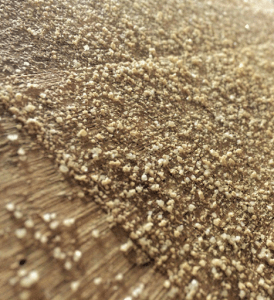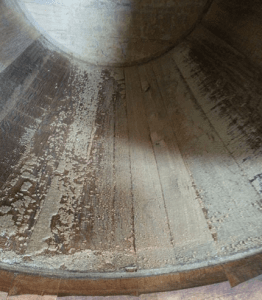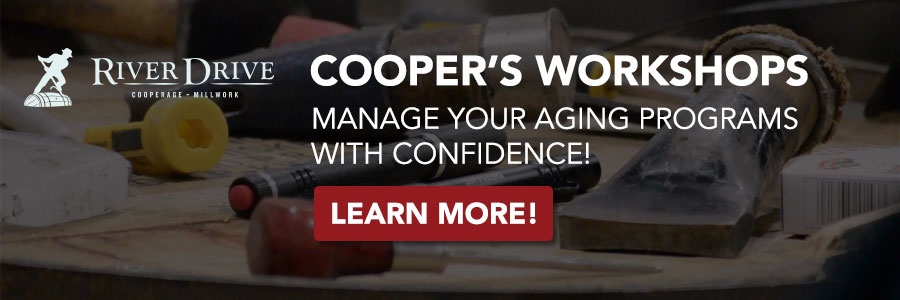Answers to Our Most Asked Questions
How do you remove a wooden bung from a barrel?
For bungs that are protruding 3/4″ or more they can be lightly tapped around the edge of the bung with a hammer to pop them out. If that doesn’t work or the bung is sunken into the barrel too much, a flat head screwdriver and a hammer work well to pry them out. Keep in mind shipping bungs are often made of soft woods, like poplar, and are not meant to be reused. It is not uncommon for these bungs to break when being removed from the barrel.
Do I need to rinse my barrels before I use them?
Many of our barrels ship wet, with spirits still inside them, for sanitation and hydration purposes. In addition, barrels are purged with an inert gas, removing oxygen. We do not see a need for these barrels to be rinsed prior to use unless required to do so by your facility’s protocol and/or TTB regulations.
Can I find out where my barrels came from?
Some sources are okay with clients knowing their name and brand, and allow their markings to remain stamped on their barrels. These barrels can cost more at times due to this “exclusivity” and branding. It is important to remember that any copyrighted and/or private brand and source information is not permitted to be shared publicly or used in marketing without specific permission.
Any markings from River Drive® or Barrels Direct® is permitted to be used respectfully and with due regard. This includes, but is not limited to, our name(s), barrel type, broker name, 5 Point Barrel Inspection, and water.org® donation program. We reserve the right to request removal of inappropriate use of this information.
Other sources are not disclosed for a variety of privacy and legal reasons. These barrels may have blank or painted over barrel heads. In some cases, these barrels contained contents that are produced in bulk by major manufacturers, then private labeled under other brands. These barrels should not be underrated! Their construction, and the contents inside, must meet extremely meticulous industrial manufacturing standards and are often some of the highest quality barrels available.
There are cracks in my barrel, what do I do?!
Our barrels pass through a comprehensive five-point inspection prior to shipping. In most cases, these are stress cracks and are not full thickness. This means that the barrel is not likely to leak. If the crack appears to be more severe, please document it with photographs and notify us within seven days of delivery.
My wine barrel has a board across the top and the bottom, can it be removed?
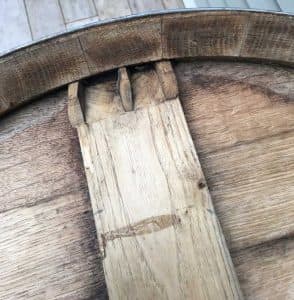
This board is not nailed in, it is a pine crossbar. There are pegs on either side that come out so the board can be removed. The pegs/board may be in very tight and it may be difficult to remove but it will come out.
What is your preferred barrel bung?
There are three general options here, solid wood, solid silicone, or vented silicone.
Solid wood bungs are either a hard or soft wood, are very inexpensive, but are not really meant for reuse. They are the traditional bung for a barrel, but when we start putting beer in barrels a lot can change, including temperature and pressure. Wooden bungs can seal the barrels so well that they may not “give” if the pressure exceeds the safe limits of a barrel. This could cause uncontrolled leaking and even catastrophic failure of the barrel. Wooden bungs also require tools to install and remove. We always recommend having a case of these laying around so you can re-bung the barrels after you empty and rinse them, before shipping them off to be recycled or reconditioned.
Solid silicone bungs are more expensive, easier to clean (can be reused if cleaned thoroughly), and don’t generally require any tools to install or remove. Silicone bungs come in a wide variety of shapes, sizes, and colors. The silicone seals the barrel well but could come out under less pressure than a wooden bung, thought that can actually be a good thing.
Vented silicone bungs are just like the solid silicone bungs but they are designed with a one-way type valve in them. This allows the pressure inside the barrel to escape but does not allow any outside air back into the barrel. The only issue vented silicone bungs can pose is if a piece of debris gets stuck in the vent, holding it open allowing outside air into the barrel. This isn’t necessarily common but anything is possible. These are also usually the most expensive bungs of the three types.
There are also combo silicone bungs that serve both the purpose of a solid and a vented. In terms of quality and brand, we have seen many of the different types pass through the cooperage. All the different types of bungs do their job well and we haven’t really seen any of lesser quality than others. We would recommend shopping around and buying whatever you find works best for you. Whether it is a certain color or colors, shape, or just cost.
Why does my barrel have wooden hoops?
Traditional Chateau style Wine barrels have two chestnut hoops on the top of each barrel and two on the bottom. These hoops are said to be a friendly tool used to control pests. Chestnut is much darker than oak but as noted above serves more than just an aesthetic purpose.
Chestnut is a softer wood than oak so the wood-boring beetles (bore bugs) are more apt to go for the chestnut hoops over the hard oak saving the barrel and the wine inside.
Chestnut hoops are also easier on the hands of cellar staff and anyone else handling the barrels than metal bands.
Can I fill/empty Wine barrels with the same standard tube I use for Bourbon/Whiskey barrels?
Yes, you can use the same standard tube to fill/empty wine barrels as you would regularly use for filling/empty Bourbon/Whiskey barrels.
Is the bunghole on a wine barrel the same size as the bunghole on a standard Whiskey Barrel?
Yes, the bunghole on a wine barrel is generally the same size as the bunghole on a standard whiskey barrel.
What is the difference between American Oak and French Oak?
A lot! But to summarize…
American Oak:
- Traditionally air dried for twelve to eighteen months prior to use
- Usually charred inside
- Commonly used for bourbons first
- Imparts flavors that are more earthy, classic “oaky” and smoky
French Oak:
- Traditionally air dried for eighteen to twenty-four months prior to use
- Usually toasted inside
- Commonly used for wines first
- Imparts flavors that are more mellow, smooth, and sweet
What is the difference between a 4” Barrel Rack and a 7” Barrel Rack?
4” barrel racks allow for stacking in areas with less headroom. Racks are usually only 43” wide and may not fit some wine barrels that have wider bilges.
7” barrel racks are the most common size racks. Usually around 44.5” wide, and fit nearly all standard size wine and whiskey barrels.
What is in my barrel?
Barrels are shipped and stored in a number of different ways depending on the source, style, and variety.
Wine Barrels: Wine style barrels may ship empty but contain sulfur or inert gases. They may also with a holding solution consisting of ingredients such as citric acid, tartaric acid, sodium metabisulfite and/or sulfur. “Chemical free” orders may ship with high proof grain neutral spirit (flavorless alcohol) to prevent spoilage.
Spirit Barrels: Often times spirit barrels will contain a small amount of the high proof spirit in them. Spirits are generally aged at a higher proof than they are bottled at. The residual spirit left behind helps keep the barrels clean and hydrated. Some spirit barrels may ship with added grain neutral spirit (flavorless alcohol) to maintain barrel health and stability while not affecting barrel profile.
How do I measure what size my barrel racks are?
The 4” and 7” numbers refer to the height of the barrel rack minus the “feet” the barrels rest on.
Why is there a film on my beer? / What is a Pellicle?
A white-ish film, sometimes bubbly or fuzzy, that may form on the top of some barrel aged beers is referred to as a pellicle. While a pellicle is common in beers fermented with Brettanomyces, Lactobacillus, or Pediococcus, the sign of a pellicle in non-intentionally infected beers is not necessarily a guarantee of infection. Pellicles may also form through the interaction of oxygen when the barrel bung is not properly sealed. A properly formed and undisturbed pellicle can even act as a shield to limit the amount of oxygen the beer comes in contact with. If there is any concern over the quality of your beer, have it tested to make sure you know what’s in there.
There’s sand, crystals, or sugar/salt like material in my barrel! What is it?
Wine Tartrates! If there appears to be a sand, crystals, sugar, or salt like matter stuck to the interior sides and heads of your wine barrel, these are Tartrates, aka “Wine Diamonds”, or potassium bitartrate. They are small, crystalline deposits that occur in wines when potassium and tartaric acid, both naturally occurring products of grapes, bind together to form a crystal. They can occur in any wine but are more common in white wines, so your white wine barrel may have more stuck inside it then your red wine barrels. Tartrates are actually seen as a sign of quality in the wine community, and they never impart a bad taste.
What is the Barrels Direct "Satisfaction Guarantee"?
Barrels Direct provides a satisfaction guarantee for all barrels supplied to our customers. All barrels are backed by our Barrel Quality Guarantee. This ensures that you will receive good, fresh, wet, leak and “bug” free barrels. Our cooperages and partners carefully check each order to ensure that it meets your expectations exactly.
Barrels Direct advises our customers to inspect all barrels on delivery and to inform us of any problem(s) that you may observe. The physical condition of the barrels must be verified on delivery. Customers have five business days in which to report any issue with their barrels.
- “Wet” does not specifically guarantee visible liquid inside the barrel, but refers to the moisture content within the staves of the barrel.
- “Leak” refers to permanent leaks that are not easily repairable or fixed by standard rehydration.
- “Bug” refers to infections such as Pediococcus, Lactobacillus, and Brettanomyces.
What is the difference between Mezcal and Tequila?
Mezcal is smokier than Tequila from overcooking the agave. Mezcal can be explained as “well done” Tequila.
What are the Char Levels and how are they different in regards to flavor impact?
Traditional Char Levels are 1-4. Lighter char levels are said to give more fruit esters and spice notes whereas darker char levels will extract more vanilla flavors and color into the product. The world’s most popular char option is Level 4. Level 4 char is sometimes referred to as “alligator char”.
Char Levels from Left to Right Pictured Below: Level 1, Level 2, Level 3 and Level 4
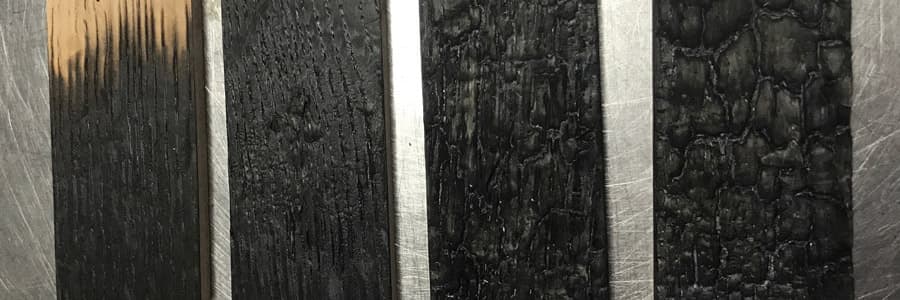
What is the difference between Bourbon and Whiskey?
Bourbon has five “rules” it needs to follow to legally be classified as a Bourbon:
1. It must be made in the United States of America.
2. It must have a mash bill of at least 51% corn.
3. It must be distilled at no higher than 160 proof.
4. It must be barreled at no higher than 125 proof.
5. It must be put into a new, charred oak container (a barrel).
Further classifications of Bourbon exist such as Kentucky Bourbon which must be produced, and then aged for at least one year in the state of Kentucky or Straight Bourbon which must be aged for a minimum of 2 years (if less than 4 years it must have an age statement on the bottle).
You may have also heard the terms “Single Barrel” or “Small Batch”. Although there is no legal definition for either of these Single Barrel implies that all the bourbon in a bottle of single barrel bourbon came from one barrel. Small Batch varies based on the size of the distillery using the term.
Whiskey is a broad term that has to follow four rules:
1. It must be made from fermented grain and only grain.
2. It is distiller no higher than 190 proof.
3. It is put into an oak container.
4. It is bottled at no less than 80 proof.
Most whiskeys have a qualifier; Scotch, Canadian, Irish, Tennessee, Rye etc.
What are the different types of Whiskey?
Tennessee Whiskey:
Tennessee Whiskey is held to the same legal definition as Bourbon expect with one addition. The spirit must be filtered through maple charcoal before it is barreled. This step in the process is called The Lincoln County Process.
Rye Whiskey:
A Rye Whiskey is a classic American Whiskey that is made from 51% or more rye.
Canadian Whiskey:
Canadian Whiskey is the most open category of Whiskey and allows flavoring to be added as well as caramel coloring can be added for color.
1. It must be produced in Canada.
2. It must be distilled at no more than 190 proof.
3. It must be aged in Canada in wooden barrels for at least three years.
Irish Whiskey:
Irish Whiskey has no defined dominant grain or production method however most is triple distilled.
1. It must be produced on the island of Ireland.
2. It must be made from cereal grains.
3. It must be distilled at no more than 190 proof.
4. It must be aged in Ireland in wooden casks for at least three years.
There are 5 types of Irish Whiskey; Single Malt, Single Grain, Single Pot Still, Grain Irish Whiskey and Blended Irish Whiskey. Irish Whiskey does not generally use peat in the malting process giving it a different flavor profile than Scotch.
Scotch Whiskey:
Scotch Whiskey has two different basic types and three different blended types.
1. It must be produced in Scotland.
2. It must be made from malted barley (may contain other cereal grains as well).
3. It must be distilled at no more than 190 proof.
4. It must be aged in Scotland in oak casks for at least three years.
5. It must contain no added substances other than caramel coloring.
The two types of basic Scotch are Single Malt and Single Grain. The three types of Blended Scotch are Blended Malt Scotch, Blended Grain Scotch and Blended Scotch.


